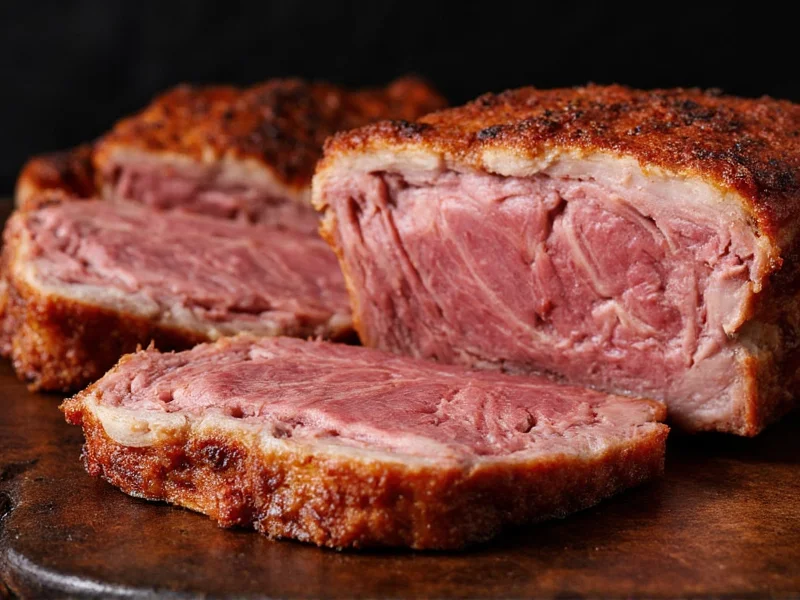Many barbecue enthusiasts confuse St. Louis style ribs with beef ribs due to naming conventions, but they're exclusively a pork product. This popular cut originated in St. Louis, Missouri, where butchers developed this specific trimming method to create a more uniform, meaty rack that appeals to commercial kitchens and backyard grillers alike.
What Makes St. Louis Style Ribs Unique
St. Louis style ribs represent a specific preparation of pork spare ribs. Butchers transform standard spare ribs by removing:
- The hard breastbone (sternum)
- Excess cartilage
- Rib tips (the meaty section at the bottom)
This meticulous trimming creates a neat, rectangular rack that cooks more evenly than traditional spare ribs. The process leaves behind the meatiest portion of the spare ribs with a consistent thickness throughout the rack.
St. Louis Style Ribs vs. Other Pork Rib Cuts
Understanding the difference between various pork rib cuts helps clarify why St. Louis style ribs stand out. The following table compares key characteristics:
| Rib Type | Source on Pig | Shape | Fat Content | Cooking Time |
|---|---|---|---|---|
| St. Louis Style | Trimmed spare ribs | Rectangular, uniform | Moderate | 4-5 hours at 225°F |
| Baby Back | Top of rib cage near spine | Curved, smaller bones | Lower | 3-4 hours at 225°F |
| Spare Ribs (untrimmed) | Lower belly section | Irregular, curved | Higher | 5-6 hours at 225°F |
| Beef Ribs | Cow's rib section | Large, substantial | Very high | 6+ hours at 225°F |
Why People Confuse St. Louis Ribs with Beef
The confusion between St. Louis style ribs and beef ribs stems from several factors. First, barbecue terminology often uses regional names that don't clearly indicate the meat source. Second, both pork and beef ribs appear on restaurant menus with similar preparation methods. Finally, the substantial size of St. Louis cut compared to baby back ribs leads some to assume they must be beef.
Unlike beef ribs, which come from the cow's rib section and feature much larger bones with significant meat coverage, St. Louis style ribs maintain the characteristic pork rib bone structure but in a more uniform arrangement. The meat-to-bone ratio remains distinctly pork-like, with tender muscle fibers that separate easily when properly cooked.
Cooking Perfect St. Louis Style Pork Ribs
These ribs respond exceptionally well to low-and-slow cooking methods. For optimal results:
- Prep the membrane: Remove the silver skin membrane from the bone side for better smoke penetration and tenderness
- Rub application: Apply a balanced dry rub 12-24 hours before cooking to allow flavors to penetrate
- Temperature control: Maintain 225-250°F throughout the cooking process
- The bend test: Check for doneness when the rack bends easily at 180-190°F internal temperature
- Resting period: Allow ribs to rest for 20-30 minutes before serving to redistribute juices
Many pitmasters use the 3-2-1 method with St. Louis style ribs: three hours unwrapped, two hours wrapped in foil with liquid, and one hour unwrapped to set the bark. This technique works particularly well with this cut due to its consistent thickness, which prevents uneven cooking that can occur with traditional spare ribs.
Where to Find Authentic St. Louis Style Ribs
While the name suggests Missouri origins, quality St. Louis cut ribs are available nationwide. When purchasing, look for:
- Meat markets with skilled butchers who can trim spare ribs to St. Louis specifications
- Packages specifically labeled "St. Louis Style" or "Pork Ribs - St. Louis Cut"
- Racks with consistent thickness and minimal bone exposure
- Good marbling throughout the meat sections
Some grocery stores sell pre-trimmed St. Louis style ribs, but you can also request your butcher trim regular spare ribs to create this cut. The distinctive rectangular shape makes them easy to identify once you know what to look for.
Flavor Profile and Serving Suggestions
St. Louis style ribs offer a perfect balance between meatiness and fat content. They contain more marbling than baby back ribs, resulting in richer flavor and juicier texture when cooked properly. The uniform shape allows for even smoke absorption and consistent bark development across the entire rack.
These ribs pair beautifully with tomato-based barbecue sauces, though many purists prefer them with just a quality dry rub to showcase the meat's natural flavor. Serve them alongside classic barbecue sides like coleslaw, baked beans, and cornbread for a complete meal that highlights this distinctive pork cut.
Frequently Asked Questions
Are St. Louis style ribs made from pork or beef?
St. Louis style ribs are exclusively made from pork. They come from the trimmed spare rib section of the pig, not from beef cattle. The confusion sometimes arises because of barbecue naming conventions, but they are definitely a pork product.
What's the difference between St. Louis style ribs and baby back ribs?
St. Louis style ribs come from trimmed pork spare ribs, creating a rectangular rack with more fat and connective tissue. Baby back ribs come from the top of the rib cage near the spine, have a curved shape, less fat, and cook faster. St. Louis cuts are meatier and more uniform in shape compared to the smaller, curved baby backs.
Why are they called St. Louis style ribs if they're pork?
The name comes from St. Louis, Missouri, where butchers developed this specific trimming method in the mid-20th century. They created this rectangular cut from pork spare ribs to make them more appealing to restaurants and consumers who preferred a uniform shape with less waste.
How long should I cook St. Louis style pork ribs?
Cook St. Louis style pork ribs at 225-250°F for approximately 4-5 hours using the low-and-slow method. Many pitmasters use the 3-2-1 technique: 3 hours unwrapped, 2 hours wrapped in foil with liquid, and 1 hour unwrapped to set the bark. The ribs are done when they reach 180-190°F internally and bend easily.











 浙公网安备
33010002000092号
浙公网安备
33010002000092号 浙B2-20120091-4
浙B2-20120091-4